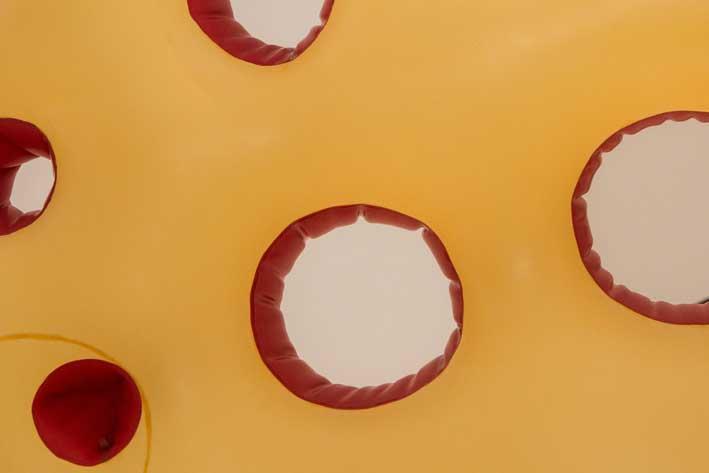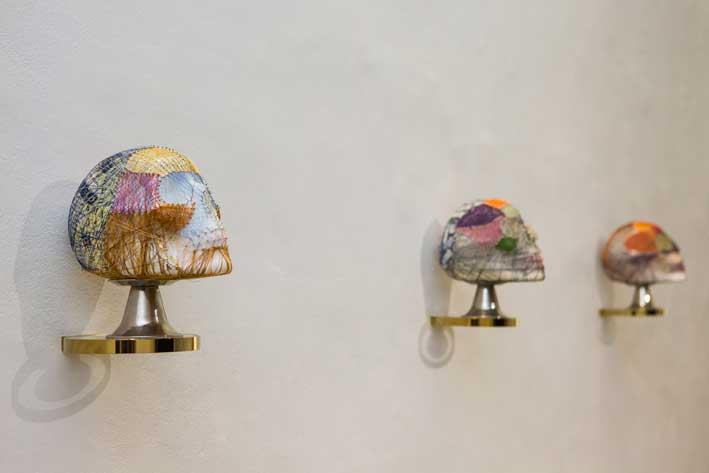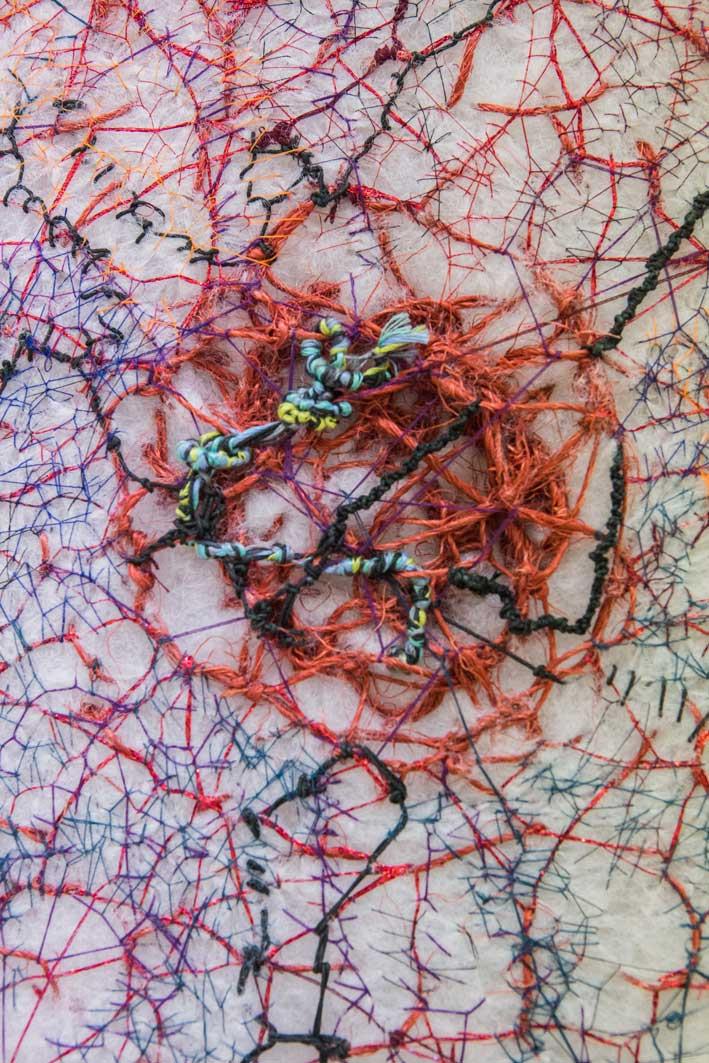Textiles, threads, latex, rubber, foam and bricks. Not the usual material list for an art exhibition, is it? Six international artists from Berlin, together with curator Verena Voigt, are questioning the concept of order in their newest exhibition at Spazju Kreattiv titled about order. Taking a universal perspective, these artists are discussing order from a wider point of view, considering both the specific cultural and individual orders.
Textiles and hand-made items feature prominently in Sandra Contreras's work. In her artistic research, she adopts cosmological questions about the beginning and end of the universe, its magnetic field while adding teachings from Pythagoras, Copernicus and Babylonian astrology in the mix. Her work Homage to Copernicus and Astrology is an example of these teachings being adopted and adapted into artworks. These handmade curtains or wall carpets are embroidered with structures from nature, body and cosmos to create complex textures. Book without reason, another embroidered object book by Contreras, becomes her personal statement and a testament of her impulsivity of trying to create something that is imprecise and illogical. She spends time dealing with topics of physical movement, drawing and self perceptions to try and verbalise her research.

Threads and textiles feature in other works along the rooms. Particularly striking in its small size is Estado de Hidalgo by María Tello Gutiérrez. The colourful threads make up a bird's eye view of Tello's hometown. From a new perspective, her once forgotten memories and stories appear back in a three-dimensional format and release poetic energy. In her artistic research, she investigates phenomena of vulnerability and healing and the objects she creates - the eye, the stomach, the skull, the skin - look like test objects on which she tests healing methods. Estómago (Spanish for stomach), for example, shows an inner movement visualised by knotting that takes over the artwork. For the artist, the stomach is a mirror of emotions: knots, tangles and possible pathological tumours. With the threads that make up her work, Tello explores the old healing powers and secrets that need to be recovered.

Héctor Velázquez Gutiérrez also examines the relationship between the human body and its surroundings by exploring physical forms and their perceptions while also investigating the interactions between the sensory organs. Using mainly textile materials such as threads and used clothing, but also materials such as silver, meteorites and obsidians, he creates physical structures that invite the viewer to create an emotional relationship with the artwork. In his photographic work, Velázquez combines the physical nature of the earth with the human body. In Tamaulipas 1, the artist is lying in front of Tamaulipas' topographical landscape while documenting a motion blur in Tamaulipas 2. Tamaulipas is a federal state in northern Mexico ruled by criminal gangs. In 2010, 72 people were murdered in this city because they refused to give them money. As a reaction to this massacre, these two photographs were created.
Photography is also used by Sabine Linse to draw inspiration from the cultural memory of art and natural histories. In both Moosmadonna and Muejeres, Linse references the artist Lucas Cranach. The representations are reminiscent of Christian depictions such as the Madonna and child in Moosmadonna where the masked figure holds a child and stands on a moss hill which signifies the rootless spore that lives in moist and shady soil. The same composition is seen in Potato Women, where Linse creates these individual, mythological figures against a dark black background and on a small hill. The creation of casual and chronological relationships made with perishable materials alternate with symbolic moments that want to be examined in detail.
Details are also essential when looking at the visibly striking and almost unmissable works by Anette Kuhn. Mostly made up of rubber or foam, Kuhn's exploration of different media is enticing and somewhat mesmerising. Basing her techniques on photography and drawings, she creates images that visitors can feel, easily locating them in the different spaces. Her work with heterogeneous visual worlds reflect her views and experiences of the world. Colourful Blauregen, which translates to "blue rain" is part of a series of foam rubber drawings in which Kuhn experiments with colour and structure. Macro photos of mushrooms are transformed in bright orange bulging spongy structures to create these dynamic structures and orders created by the colour.

Just as colourful are works by Mariel Poppe. Transplants are reminiscent of cells, organs and membranes in the human body which float in space. Pores, on the other hand, show the artist's investigation into the skin-like feeling and elasticity of the material, resulting in special shapes and protuberances. Her research in organic forms of growth such as co-existing systems in human, plant and animal organisms, lead her interests in seemingly abnormal and abstruse forms. The inflatable latex objects are fragile shells that Poppe chooses to connect with tubes, hanging down from IV poles, floating in the air or lying on the floor.
The artists collectively come together to manipulate the concept of order in many ways, shapes and forms. Having worked together since the 1990s, they truly show their ability to integrate their works with each other even though they are individualistic and play into every artist's artistic form.
About order is exhibited in Space C until 6 December. Spazju Kreattiv is encouraging visitors to attend and experience the exhibition in person. It is also providing ample opportunities for visitors to access an online gallery and features from the artists and curator.
The outreach programme for this exhibition is being carried out on the basis of cooperation with Prof. Ruth Bianco, University of Malta, Visual Arts, Faculty for the Built Environment, Dept of Architecture & Urban Design, Diploma for Design, Foundation Studies. This project is funded by the Berlin Senate Department for Culture and Europe, German-Maltese Circle, Valletta and Frank-Basten-Stiftung, Leipzig.
For more information visit www.kreattivita.org
Audrey Rose Mizzi is Marketing & Communications senior officer at Spazju Kreattiv